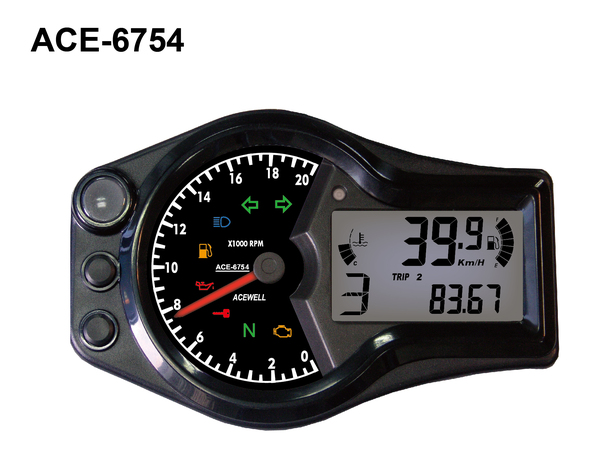Tachometer Fundamentals: Whatever You Need to Know for Accurate Readings
Tachometer Fundamentals: Whatever You Need to Know for Accurate Readings
Blog Article
Checking Out the Functions and Advantages of a Tachometer: A Comprehensive Overview for Vehicle Lovers
In the world of auto instrumentation, the tachometer stands as a crucial tool that offers chauffeurs beneficial insights into their vehicle's performance. tachometer. From providing real-time data on engine rate to assisting in maximizing equipment changes, the tachometer functions as even more than just a dial on the dashboard. Its diverse features not just improve driving experience but additionally play a crucial role in keeping engine wellness and efficiency. As we look into the intricate operations and benefits of a tachometer, a much deeper understanding of its significance for vehicle enthusiasts and professionals alike will certainly unravel.
Comprehending the Basics of a Tachometer
In the world of vehicle instrumentation, comprehending the basics of a tachometer is crucial for any type of cars and truck lover looking to dive into the details of engine performance monitoring. A tachometer, commonly shown on the control panel of a car, measures the engine's transformations per minute (RPM) This important instrument gives real-time data on just how fast the engine crankshaft is revolving. By keeping an eye on the RPM, drivers can guarantee they are operating within the ideal array to make the most of efficiency and performance.
Tachometers generally have a scale noted in revolutions per min, with a redline indicating the optimum rate at which the engine can safely run (tachometer). This details is essential for avoiding engine damages and enhancing gear shifting for hand-operated transmissions. Additionally, tachometers can assist in identifying engine concerns such as misfires or a stopping working ignition system by identifying irregular RPM analyses
Value of Keeping An Eye On Engine Rate

The engine speed, gauged in revolutions per minute (RPM), shows exactly how quickly the engine's crankshaft is revolving. Checking engine speed is particularly critical throughout equipment shifts, as it assists drivers identify the right time to alter gears for smooth velocity and effective fuel intake.
In addition, tracking engine rate can likewise provide beneficial understandings into the total health of the vehicle. Generally, checking engine speed with a tachometer is a fundamental technique that can improve driving performance, prolong engine life, and guarantee a much safer and much more pleasurable driving experience.
Enhancing Performance Via Equipment Shifts
Maximizing efficiency through calculated equipment shifts is a key aspect of taking full advantage of a vehicle's efficiency and power result. Appropriate equipment shifting makes sure that the engine operates within its ideal power band, permitting for smooth velocity and improved gas economic situation. When moving gears, it is important to take note of the engine speed suggested on the tachometer. By monitoring the engine transformations per minute (RPM), vehicle drivers can establish the most favorable minutes to upshift or downshift for optimum performance.

To attain peak efficiency via equipment changes, drivers should practice smooth and timely shifts in between gears, matching engine rate with road rate to harness the full capacity of their automobile's powertrain.
Making The Most Of Effectiveness With a Tachometer
Grasping the art of gear changing in high-performance automobiles not only improves driving experience but also plays a crucial duty in maximizing efficiency with a tachometer. tachometer. By paying close interest to the tachometer readings, motorists can enhance their equipment shifts to run within the engine's most reliable variety. When accelerating, changing equipments at the best RPM shown by the tachometer can stop the engine from exhausting or underperforming, bring about improved fuel efficiency and total performance
In try this website addition, a tachometer helps chauffeurs avoid unneeded revving, which not just throws away gas however additionally places unneeded pressure on the engine. Constantly monitoring the tachometer while driving allows for smoother equipment changes, lowering damage on the transmission system in time.

Advanced Tips for Tachometer Use
Enhancing driving precision via proficient tachometer analysis is essential to optimizing automobile performance. To explore innovative pointers for tachometer application, consider including using change lights. Change lights are visual signs that illuminate when it's time to move equipments based on engine revolutions per min (RPM), enabling for smooth gear modifications without constantly keeping an eye Bonuses on the tachometer. Furthermore, exercising heel-and-toe downshifting strategy can be useful when going for smoother shifts between gears. This technique includes using both the brake and accelerator pedals at the same time while downshifting, assisting to preserve engine RPM and avoid jerky activities. In addition, making use of a performance tachometer with personalized setups can provide real-time data tailored to details driving preferences or vehicle modifications. By fine-tuning change factors and establishing cautioning thresholds, drivers can maximize acceleration and engine performance while decreasing the danger of over-revving. These advanced techniques, when coupled with a deep understanding of tachometer analyses, can boost driving proficiency and general driving experience.
Verdict
In conclusion, the tachometer acts as a vital tool for auto enthusiasts to keep track of engine rate, improve performance with equipment shifts, and maximize effectiveness. By understanding the features and advantages of a tachometer, motorists can optimize their driving experience and extend the lifespan of their automobile. Making use of innovative ideas for tachometer usage can better boost driving skills and total efficiency when driving.
Report this page